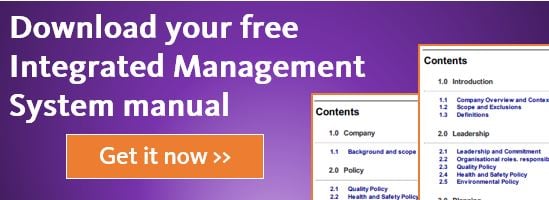Since ISO 9001 became a standard back in 1987, one of its most debated issues is the number and type of documents that the standard requires.
Where documentation is concerned, most people have erred on the side of “too much ain’t enough”. It could be argued that these days the standard is to document everything single little thing. Just in case, you know? Just like everybody else, right?
Consultants have had a field day in this environment, making millions of dollars from creating a blizzard of policies, procedures, forms, checklists and templates. Consultants have an interest in creating more documents because for them, that’s money in the bank. Consultants then get to have a second crack when they regularly audit the same documents.
If non-conformances are found then they demand that more documents be created to meet another part of the standard. It’s a never-ending spiral of more and more documentation.
Over the years many critics have slammed ISO 9001, saying that “getting certified to the standard is only a documentation exercise”. And it’s easy to make this point – some companies do indeed create and maintain literal rooms full of documents, their justification being that the standard itself demands it. It could be argued that the standard is its own worst enemy.
I believe that the madness around documentation is the reason why ISO 9001 hasn’t become more popular. According to ISO over a million companies have been certified …but that number is tiny compared with the potential number that could be certified. Companies are reluctant to sign up to creating a paper tsunami, judging that the gains to be made simply aren’t worth it.
Certification Bodies and Documented Information
Certification bodies have a case to answer here, too. Such bodies demand that documents be created so that you can pass an audit. Just today a manufacturing client of Mango was asked by a certification body to rewrite its manual to meet the clauses of the standard. What value does this bring to the company? I’d argue that there is actually no value at all, and that in fact it’s a big negative - a costly time suck! Just because the auditor can’t interpret the manual to the standard for documentation doesn’t mean that the company should be penalised for auditor laziness.
So the question is, “how many documents do I need?”
All that the standard says is that the organization shall determine the amount of documents “necessary for the effectiveness of the quality management system”. That’s a pretty broad stretch from zero to a lot. So it really is up to you to ensure your QMS is being managed effectively.
Let's start with what the standard doesn't require:
- Quality Manual
- Forms Register
- Records Register
- Document Register
- Document Change Register
But what it does require is:
- Document identification and description
- Appropriate format (language, software version, graphics, paper, electronic)
- Review and approval
- Available for use
- Protected (e.g. from loss of confidentiality, improper use, or loss of integrity)
- Controlled (distribution, access, retrieval and use; storage and preservation, including preservation of legibility; changes; retention and disposition).
So here at Mango we thought long and hard about what we needed for our QMS and we decided to create a Quality Manual. After many years in this game we thought having a quality manual was of greater value than not. The Quality Manual is a great tool for:
- Communicating the QMS to staff
- Training new employees in the QMS
- Help with managing contractors understand our QMS requirements
- Providing to customers if they want to see and audit the QMS
Fortunately for us we also use our product Mango to control much of our documented information. Mango holds the quality manual, all the forms we use and many of the records we use to prove compliance to the ISO 9001 standard and for legal and regulatory requirements.
Our system isn’t an overwhelming paper tsunami – it’s a trim, concise and easy-to-navigate system that gets used.
Takeaways
Here is a list of takeaways that will help you meet the 7.5 clauses:
- Determine what an effective QMS looks like
- Remember that documents are only necessary for the effective management of the quality management system
- Determine how large your QMS will look
- A Quality Manual is not required but it can be useful
- The over-riding principle is that documented information must be managed and controlled
View previous blogs in this series "How to Implement a QMS and Achieve ISO 9001 Certification":
How to Implement a QMS and Achieve ISO 9001 Certification - Part 1: Introduction
How to Implement a QMS and Achieve ISO 9001 Certification - Part 2: Customer Focus
How to Implement a QMS and Achieve ISO 9001 Certification - Part 3: Leadership
How to Implement a QMS and Achieve ISO 9001 Certification - Part 4: Engagement of People
How to Implement a QMS and Achieve ISO 9001 Certification - Part 5: Process Approach
How to Implement a QMS and Achieve ISO 9001 Certification - Part 6: Improvement
How to Implement a QMS and Achieve ISO 9001 Certification - Part 7: Evidence Based Decision Making
How to Implement a QMS and Achieve ISO 9001 Certification - Part 8: Relationship Management
How to Implement a QMS and Achieve ISO 9001 Certification - Part 12: Clause 5.2 Policy
How to Implement a QMS and Achieve ISO 9001 Certification - Part 15: Clause 6.2 Objectives
How to Implement a QMS and Achieve ISO 9001 Certification - Part 16: Clause 7.1 Resources





